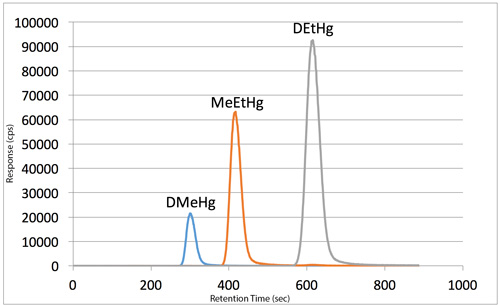Dimethylmercury (DMeHg) is an extremely dangerous neurotoxin that can bioaccumulate in the body following exposure. This compound is not used in industry due to the risks involved, but it has been found to be produced under certain conditions when wastes containing mercury are stored. DMeHg is a liquid, but it has a very low vapor pressure, so it can be readily detected in the air as well. Recently, there has been a growing concern regarding exposure to DMeHg for workers.
Brooks Applied Labs developed a method for the detection of DMeHg and other volatile mercury compounds decades ago. Our primary method utilizes cold vapor generation with gas chromatography coupled to an atomic fluorescence spectrophotometer (CV-GC-AFS), and this method is validated by a secondary technology using reverse-phase chromatography for the separation and ICP-MS detection (RP-ICP-MS). An added benefit of these methods is the capability to quantify methylethylmercury (MeEtHg) and diethylmercury (DEtHg) compounds, allowing for a more complete evaluation of the mass balance of the mercury species in a sample.
Chromatogram for 10 ppb DMeHg, 30 ppb MeEtHg, and 50 ppb DEtHg by RP-ICP-MS

To learn more about the full range of mercury speciation capabilities at Brooks Applied Lab or to discuss how analysis for various mercury compound could benefit your next project, please contact us.
